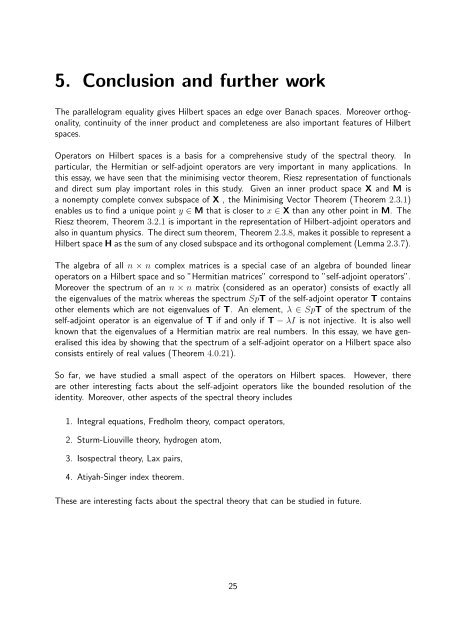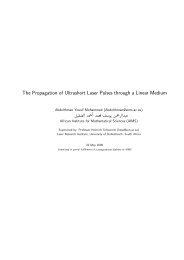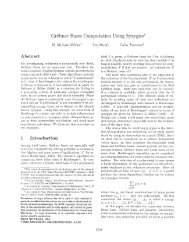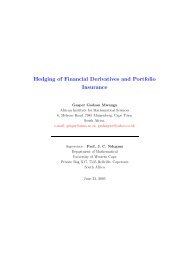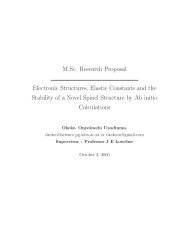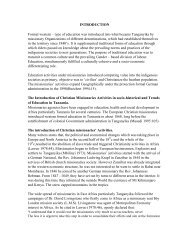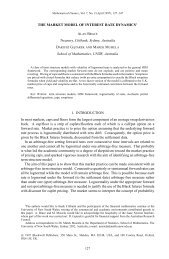Operators on Hilbert Spaces - user web page - AIMS
Operators on Hilbert Spaces - user web page - AIMS
Operators on Hilbert Spaces - user web page - AIMS
You also want an ePaper? Increase the reach of your titles
YUMPU automatically turns print PDFs into web optimized ePapers that Google loves.
5. C<strong>on</strong>clusi<strong>on</strong> and further work<br />
The parallelogram equality gives <strong>Hilbert</strong> spaces an edge over Banach spaces. Moreover orthog<strong>on</strong>ality,<br />
c<strong>on</strong>tinuity of the inner product and completeness are also important features of <strong>Hilbert</strong><br />
spaces.<br />
<str<strong>on</strong>g>Operators</str<strong>on</strong>g> <strong>on</strong> <strong>Hilbert</strong> spaces is a basis for a comprehensive study of the spectral theory. In<br />
particular, the Hermitian or self-adjoint operators are very important in many applicati<strong>on</strong>s. In<br />
this essay, we have seen that the minimising vector theorem, Riesz representati<strong>on</strong> of functi<strong>on</strong>als<br />
and direct sum play important roles in this study. Given an inner product space X and M is<br />
a n<strong>on</strong>empty complete c<strong>on</strong>vex subspace of X , the Minimising Vector Theorem (Theorem 2.3.1)<br />
enables us to find a unique point y ∈ M that is closer to x ∈ X than any other point in M. The<br />
Riesz theorem, Theorem 3.2.1 is important in the representati<strong>on</strong> of <strong>Hilbert</strong>-adjoint operators and<br />
also in quantum physics. The direct sum theorem, Theorem 2.3.8, makes it possible to represent a<br />
<strong>Hilbert</strong> space H as the sum of any closed subspace and its orthog<strong>on</strong>al complement (Lemma 2.3.7).<br />
The algebra of all n × n complex matrices is a special case of an algebra of bounded linear<br />
operators <strong>on</strong> a <strong>Hilbert</strong> space and so ”Hermitian matrices” corresp<strong>on</strong>d to ”self-adjoint operators”.<br />
Moreover the spectrum of an n × n matrix (c<strong>on</strong>sidered as an operator) c<strong>on</strong>sists of exactly all<br />
the eigenvalues of the matrix whereas the spectrum SpT of the self-adjoint operator T c<strong>on</strong>tains<br />
other elements which are not eigenvalues of T. An element, λ ∈ SpT of the spectrum of the<br />
self-adjoint operator is an eigenvalue of T if and <strong>on</strong>ly if T − λI is not injective. It is also well<br />
known that the eigenvalues of a Hermitian matrix are real numbers. In this essay, we have generalised<br />
this idea by showing that the spectrum of a self-adjoint operator <strong>on</strong> a <strong>Hilbert</strong> space also<br />
c<strong>on</strong>sists entirely of real values (Theorem 4.0.21).<br />
So far, we have studied a small aspect of the operators <strong>on</strong> <strong>Hilbert</strong> spaces. However, there<br />
are other interesting facts about the self-adjoint operators like the bounded resoluti<strong>on</strong> of the<br />
identity. Moreover, other aspects of the spectral theory includes<br />
1. Integral equati<strong>on</strong>s, Fredholm theory, compact operators,<br />
2. Sturm-Liouville theory, hydrogen atom,<br />
3. Isospectral theory, Lax pairs,<br />
4. Atiyah-Singer index theorem.<br />
These are interesting facts about the spectral theory that can be studied in future.<br />
25


